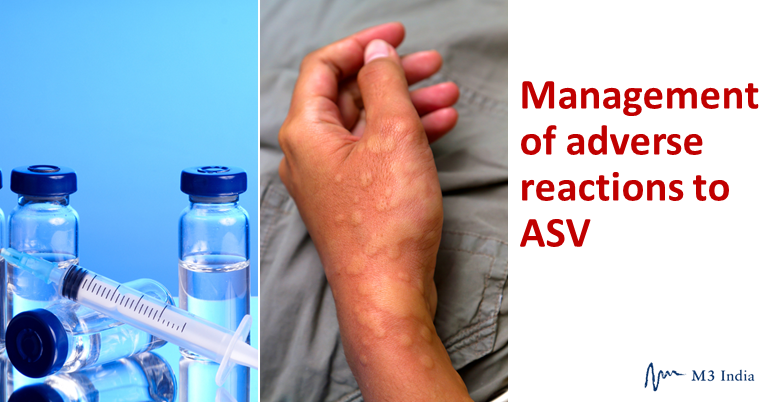Management of Adverse Reactions to Anti-Snake Venom (ASV)
M3 India Newsdesk Nov 17, 2019
Nearly 97% of snakebite deaths occur in rural areas, largely due to delayed or inappropriate treatment. This aside, another major concern is the general apprehension that arises among clinicians during management of antivenom associated adverse reactions.

Anti-snake venom (ASV) is the only definitive treatment to neutralise snake venom in circulation and in tissue fluid. However, it has high propensity to cause allergic reactions. ASV should therefore only be used in cases with evidence of systemic envenomation. At the earliest sign of an adverse reaction to an ASV, the antivenom administration must be temporarily suspended and adrenaline (0.5 ml of 0.1 %) must be administered intra-muscularly.
Snake-bites are highly prevalent in rural areas. As per a mortality survey, published in 2011, in the journal, PLoS neglected tropical diseases, nearly 97% of snakebite deaths in India occurred in rural areas. Poor access to health facilities and lack of first aid awareness in these areas are the reasons for delayed and inappropriate treatment, and increased mortality.
Insufficient knowledge and experience among healthcare providers is another point of concern. This may be because snakebite management is not given enough focus in the medical curriculum. Apprehensions among the health workers about managing antivenom associated adverse reactions have also been identified.
The rationale use of Anti-snake venom (ASV) is the only definitive treatment to neutralise venom in circulation and in tissue fluid. In India only polyvalent ASV is available. Antivenins for the following venomous snakes are currently available:
- Naja naja (Cobra)
- Bungarus caeruleus (Krait)
- Daboi russelli (Russell's viper)
- Echis carinatus (Saw-scaled viper)
ASV is prepared from horse serum and is associated with allergic reactions which may be either immediate or delayed. The incidence of antivenom reactions is increased with the dose of antivenom and speed of administration.
ASV should be used only in cases with evidence of systemic envenomation. However, in life-threatening cases, early administration of ASV is crucial to neutralise the maximum circulating venom before it gets fixed in the tissue.
Antivenom reactions
Early anaphylactic reactions: Anaphylactic reactions may occur in about 10 to 180 minutes of starting antivenom treatment. Anaphylaxis is characterised by urticaria, cough, nausea, vomiting, abdominal colic, diarrhea and tachycardia. Hypotension, bronchospasm and angioneuritic edema may occur in severe cases – which may even prove to be fatal. Anaphylactic reactions occur due to direct activation of complement by IgG and residual FC fragment or direct stimulation of mast cells and basophils by antivenin proteins.
Pyrogenic reactions: It usually develops 1-2 h after starting ASV therapy. The pyrogenic response is characterized by chills, shivering, rigors, goosebumps, hypotension and fever. These reactions are caused by pyrogen contamination during the manufacturing process.
Late serum sickness type reactions: The delayed version involves serum sickness, which develops in 1-12 days after antivenin therapy (mean 7 days). Serum sickness type reactions are characterized by fever, rash, myalgia, arthritis, mononeuritic multiplex, recurrent urticaria, lymphadenopathy, neuritis, encephalopathy and arthralgia. Oral antihistamines are recommended in such cases.
Prediction of antivenom reactions
Majority of antivenom reactions result from direct complement activation and not from IgE mediated hypersensitivity. Skin and conjunctival hypersensitivity tests are thus not helpful to predict the reaction and hence should not be used.
Contraindications to Antivenom
There is no absolute contraindication to antivenom treatment, but care should be taken in the following patients:
- Those who have reacted to horse or sheep serum in the past
- Those with a strong history of atopic diseases (especially severe asthma)
In such high risk patients, antivenom should be administered only if there are signs of systemic envenoming.
Management of antivenom reactions
- On sensing reaction, the ASV infusion should be stopped immediately and intramuscular adrenaline 0.5 ml of 0.1 % should be administered on lateral of the thigh. The dose can be repeated if not controlled.
- In life-threatening situations, adrenaline 1000 µg (one ml) is to be diluted in 9 mL of normal saline and total 10 ml. 1 ml of the solution (100 microgram adrenalin) can be administered intravenously every 5 minutes till reaction subsides.
- In addition to adrenaline, intravenous aminophylline, intravenous normal saline, H1 blocker, chlorpheniramine maleate, intravenous methylprednisolone, and nasal oxygen may be required as well as endotracheal intubation and ventilation. Head should be at a lower position.
- If the patient develops another reaction, irrespective of due care, one can try ASV from another batch.
- Antivenom should not be given intramuscularly and should be always be administered by a qualified person. Turbid solution of ASV may precipitate severe reaction and should be discarded.
The quest to improve treatment
Given the extent of snakebite and the socio-economic effect on the lives of people in rural India, measures to reduce the incidence and improve the treatment is the need of the hour.
Increasing the availability of bivalent antivenoms would reduce the dose requirement and demand of polyvalent antivenoms, and would increase patient survival and recovery. Scientists in India should therefore prepare bivalent antivenoms suitable for Indian cobra, krait, and vipers.
Encouraging clinicians to participate in regular workshops on epinephrine prophylaxis and management of anaphylaxis, has contributed substantially in reducing the risk of anaphylaxic reactions to polyvalent snake antivenom. This has resulted in a rapid reduction of morbidity and mortality in rural Maharashtra.
This article was originally published on June 10, 2019.
-
Exclusive Write-ups & Webinars by KOLs
-
Daily Quiz by specialty
-
Paid Market Research Surveys
-
Case discussions, News & Journals' summaries